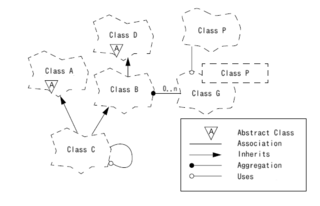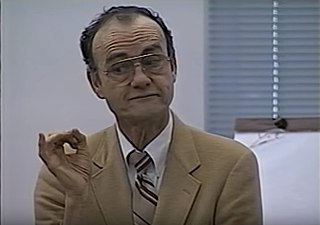
The Booch method is a method for object-oriented software development. It is composed of an object modeling language, an iterative object-oriented development process, and a set of recommended practices.

The unified modeling language (UML) is a general-purpose modeling language that is intended to provide a standard way to visualize the design of a system.
The waterfall model is a breakdown of project activities into linear sequential phases, meaning they are passed down onto each other, where each phase depends on the deliverables of the previous one and corresponds to a specialization of tasks. The approach is typical for certain areas of engineering design. In software development, it tends to be among the less iterative and flexible approaches, as progress flows in largely one direction through the phases of conception, initiation, analysis, design, construction, testing, deployment and maintenance. The waterfall model is the earliest SDLC approach that was used in software development.

Software architecture is the set of structures needed to reason about a software system and the discipline of creating such structures and systems. Each structure comprises software elements, relations among them, and properties of both elements and relations.
The rational unified process (RUP) is an iterative software development process framework created by the Rational Software Corporation, a division of IBM since 2003. RUP is not a single concrete prescriptive process, but rather an adaptable process framework, intended to be tailored by the development organizations and software project teams that will select the elements of the process that are appropriate for their needs. RUP is a specific implementation of the Unified Process.
In software and systems engineering, the phrase use case is a polyseme with two senses:
- A usage scenario for a piece of software; often used in the plural to suggest situations where a piece of software may be useful.
- A potential scenario in which a system receives an external request and responds to it.

Grady Booch is an American software engineer, best known for developing the Unified Modeling Language (UML) with Ivar Jacobson and James Rumbaugh. He is recognized internationally for his innovative work in software architecture, software engineering, and collaborative development environments.
James E. Rumbaugh is an American computer scientist and object-oriented methodologist who is best known for his work in creating the Object Modeling Technique (OMT) and the Unified Modeling Language (UML).

Ivar Hjalmar Jacobson is a Swedish computer scientist and software engineer, known as major contributor to UML, Objectory, Rational Unified Process (RUP), aspect-oriented software development and Essence.
Object-oriented analysis and design (OOAD) is a technical approach for analyzing and designing an application, system, or business by applying object-oriented programming, as well as using visual modeling throughout the software development process to guide stakeholder communication and product quality.

Alistair Cockburn is an American computer scientist, known as one of the initiators of the agile movement in software development. He cosigned the Manifesto for Agile Software Development.
The open unified process (OpenUP) is a part of the Eclipse process framework (EPF), an open source process framework developed within the Eclipse Foundation. Its goals are to make it easy to adopt the core of the rational unified process (RUP) / unified process.

The unified software development process or unified process is an iterative and incremental software development process framework. The best-known and extensively documented refinement of the unified process is the rational unified process (RUP). Other examples are OpenUP and agile unified process.
Rational Rose XDE, an "eXtended Development Environment" for software developers, integrates with Microsoft Visual Studio .NET and Rational Application Developer. The Rational Software division of IBM, which previously produced Rational Rose, wrote this software.
The UPEDU or Unified Process for Education is a software development process specialized for education, developed by Pierre-N. Robillard, Philippe Kruchten and Patrick d'Astous.
The essential unified process for software development, or EssUP, was invented by Ivar Jacobson as an improvement on the rational unified process. It identifies practices, such as use cases, iterative development, architecture driven development, team practices and process practices, which are borrowed from RUP, CMMI and agile development. The idea is that you can pick those practices that are applicable to your situation and combine them into your own process. This is considered an improvement with respect to RUP, because with RUP the practices are all intertwined and cannot be taken in isolation.
Scott W. Ambler is a Canadian software engineer, consultant and author. He is an author of books about the Disciplined Agile Delivery toolkit, the Unified process, Agile software development, the Unified Modeling Language, and Capability Maturity Model (CMM) development.

Winston Walker Royce was an American computer scientist, director at Lockheed Software Technology Center in Austin, Texas. He was a pioneer in the field of software development, known for his 1970 paper from which the Waterfall model for software development was mistakenly drawn.

A RUP ‘hump’ is a plot of effort spent over time during a particular Rational Unified Process (RUP) discipline. The RUP hump chart consists of a collection of humps for all RUP disciplines. This diagram was created in 1993 during a workshop on architecture and process and was inspired by work by Grady Booch and Boehm. It has been part of the Rational Objectory Process after reviews by Dyrhage and Bylund and moved on to play a more important role in the RUP in 1998 when it served as the initial page for using the digital version of the process. Its final form was published by Philippe Kruchten in 1998. An older version as later used by Jacobson, Booch and Rumbaugh and an altered version was used by Royce.
Hans-Erik Eriksson is a Swedish computer scientist, organizational theorist, co-founder of Open Training AB, and author, known for his 2000 work on "Business modeling with UML."









